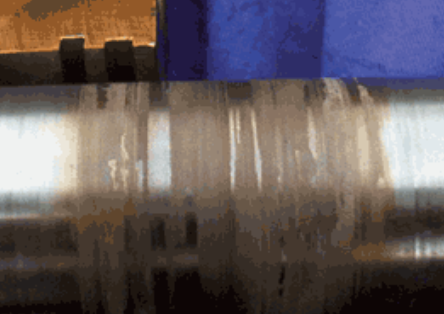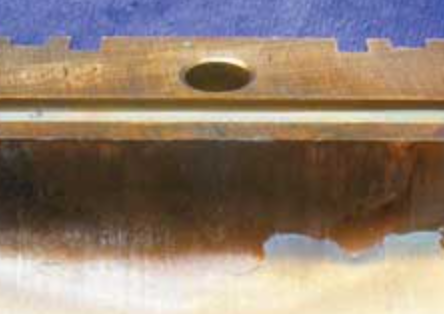What is Varnish?
Varnish is a polar submicron-sized soft contaminate.
Varnish Issues, Testing, and Solutions
It is thought to be approximately 0.01 microns in size. Its small size has spawned a new field of study known as submicron particle counts. As a soft, insoluble contaminant, it is not definable as liquid or solid. Temperature alone can change it from soluble to insoluble and back again.
 |
 |
 |
Because of this, trapping varnish is challenging. Even so, because it is polar and can receive either a positive or negative electrical charge, it can be employed in attempts to catch varnish.
Varnish Contamination
Varnish contamination is a widespread issue in many gas turbine oils. Many papers are available discussing varnish contamination, its causes, and remedies. The polar features of varnish content have been acknowledged as a proven fact in most of these articles.
The varnish is known to have polar characteristics in general. But it can also contain non-polar constituents. Varnish is difficult to define since there is no one kind. Several factors influence the varnish that forms, including operation circumstances, oil type, and environmental factors.
Rather than attempting to place specific parameters on the properties of varnish, below is a list of things that should be understood about varnish as it applies to lubrication.
Issues
Varnish production can begin with lubricant and other fluid oxidation and polymerization or with pressure-induced thermal deterioration and dieseling. Although there are many different varnish causes, these are the most notable.
Varnish is submicron in size and consists of adherent oxide or carbonaceous material. Its components include thermo-oxidative compounds of base oil molecules and additives, wear metals and impurities such as dirt and moisture. The oil is subjected to thermal deterioration and oxidation during cyclical transitions between heating and cooling.
The precipitation of high-molecular-weight insoluble oxides from the oil causes the production of varnish and sludge. These oxides have restricted solubility in a non-polar base oil like turbine oil since they are polar compounds.
This results in forming a thin, insoluble layer on the internal surfaces of machine parts, causing sticking and malfunctioning of close-clearance moving parts such as servo-valves. The varnish color on internal machine parts can change from tan to a dark lacquer-like substance.
Varnish can also be caused by entrained air bubbles undergoing adiabatic compression in load zones. These air bubbles are compressed, leading to the thermal decomposition of the oil and additives.
Group II base stocks are more resistant during the initial stages of oxidation and the formation of oxidation byproducts. But, these base stocks may become more prone to varnish difficulties when more oxidation byproducts emerge due to their high polarity. High-pressure differential zones, lengthy dwell durations, and impurities such as water can all increase oxidation.
Testing
Besides the darkening of the oil, the varnish potential can be monitored by recognizing any residue, tar, or gummy-like material in sight glasses, interior machine surfaces, filter elements, and centrifugal separators.
Oil examination employing Fourier Transform Infrared (FTIR) spectroscopy, an ultracentrifuge, colorimetric analysis, gravimetric analysis, and Membrane Patch Colorimetry (MPC) may also be used to test varnish potential.
With the recently published varnish potential test standards such as MPC and ASTM D7842, determining an acceptable level of varnish measurement can provide trouble-free operation and report unacceptable levels that would warrant taking measures to prevent and remove varnish from lubrication systems.
MachineCheck™ 813
CRE Philippines also offers a test package for varnish and sludge called MachineCheck™ 813. The package includes individual tests on the following:
- RDE Fine Wear Metal – 18 elements ASTM D6595
- RFS Coarse Wear Metal – 11 elements AES-RFS
- Oil Condition (Oxidation, Nitration) ASTM E2412
- Viscosity @40 degrees C or 100 degrees C ASTM D445
- TAN (Total Acid Number) ASTM D974M*
- % Moisture ASTM D6304B
- Particle Count (Oil Cleanliness)
- MPC Varnish Potential Testing ASTM D7843
Each test package includes a detailed oil sample report with findings, evaluation, interpretation, suggestions, and recommendations. Actionable recommendations to address varnish build-up may include the use of a portable, offline filtration cart or similar system.
Solutions
Here are some of the best practices for managing varnish:
- Don't buy oil based on price specifications. Request guidance from the manufacturer, third-party advisors, and general industry perspectives. Remember, an approved vendor list does not state which oil is the best or worst performer.
- Keep the oil clean from the moment of commissioning in the case of new units. Keep existing units clean from the very moment of replenishing oil. The worst assumption you can make is that the oil does not need to be kept clean because it is the new oil.
- Have the oil in your machine examined to see whether there is an existing or prospective varnish problem. Apply the appropriate varnish-removal system according to your equipment type, oil type, and reservoir size.
- Check your oil with a third-party oil analysis service. Do not rely on free oil analysis provided by an OEM or an oil provider.
For some types of antioxidant additives, such as phenyl-alpha-naphthylamine (PANA), additive depletion can cause varnish. When depleted, this synergistic additive rejuvenates itself, but it does so by producing a soft and polar byproduct. This byproduct, known as varnish, is recognizable since its solubility is temperature sensitive.
Oil will seem cloudy at room temperature and clear at higher working temperatures. Additive incompatibilities can be major or minor and almost always present, even when mixing brands or types of oils within the same base-stock category.
Oil Analysis Program
The focus on the varnish issue has acted as a reminder that prevention is far less expensive than cure. Maintaining things clean from the start is more straightforward than cleaning them up after they have become dirty. According to most conservative research estimates, the relative cost savings range from 80 to 90 percent. In other words, implementing a contamination avoidance program only costs 10 to 20 percent more than removing the pollutants after they are in the system.
Implementing maintenance programs to diagnose incipient machine failure through oil analysis entails cost. As such, thorough planning must be done to ensure that your resources are well-spent.
With CRE, you can confidently start your oil analysis program through CRE MachineDiagnostics™ Program, knowing you will have our full support at every step. Our program also includes a supportive seminar, Machine Wear Analysis Basic Seminar, to ensure your people know the best lubrication practices. We also have a dedicated support team that handles all your concerns on our reports. You will also have easy access to the advice of our capable and certified Lube Analysts and Machinery Lubrication Consultants whenever you need more in-depth explanations and comprehensive, actionable recommendations. Contact us through this link to learn more.
Sources:
Noria Corporation. (n.d.). 10 Things You Should Know About Varnish. MachineryLubrication. Retrieved from https://www.machinerylubrication.com/Read/30236/know-about-varnish
Sitton, A., & Sirisithichote, T. (n.d.). The Varnish Issue: Strategies for Successful Monitoring and Acceptable Levels. MachineryLubrication. Retrieved from https://www.machinerylubrication.com/Read/29768/varnish-levels-monitoring


